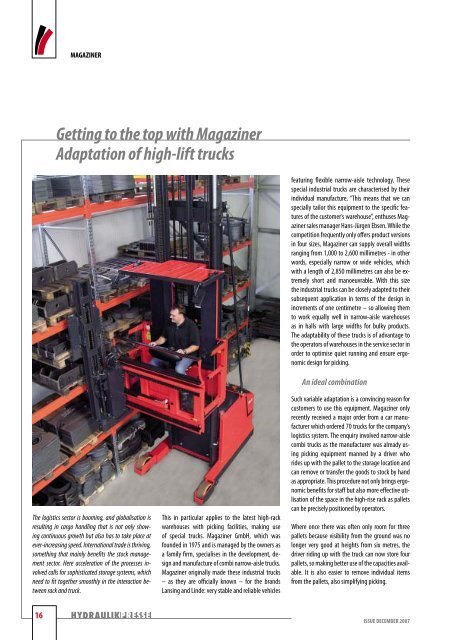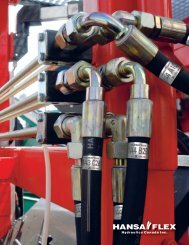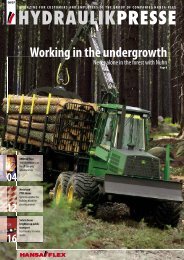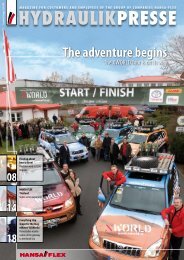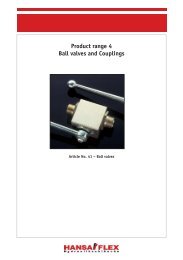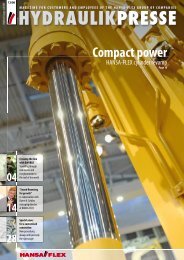HYDRAULIKPRESSE - HANSA-FLEX Hydraulics Canada Inc.
HYDRAULIKPRESSE - HANSA-FLEX Hydraulics Canada Inc.
HYDRAULIKPRESSE - HANSA-FLEX Hydraulics Canada Inc.
Create successful ePaper yourself
Turn your PDF publications into a flip-book with our unique Google optimized e-Paper software.
MAGAZINER<br />
The logistics sector is booming, and globalisation is<br />
resulting in cargo handling that is not only showing<br />
continuous growth but also has to take place at<br />
ever-increasing speed. International trade is thriving,<br />
something that mainly benefi ts the stock management<br />
sector. Here acceleration of the processes involved<br />
calls for sophisticated storage systems, which<br />
need to fi t together smoothly in the interaction between<br />
rack and truck.<br />
16<br />
Getting to the top with Magaziner<br />
Adaptation of high-lift trucks<br />
<strong>HYDRAULIKPRESSE</strong><br />
This in particular applies to the latest high-rack<br />
warehouses with picking facilities, making use<br />
of special trucks. Magaziner GmbH, which was<br />
founded in 1975 and is managed by the owners as<br />
a family fi rm, specialises in the development, design<br />
and manufacture of combi narrow-aisle trucks.<br />
Magaziner originally made these industrial trucks<br />
– as they are offi cially known – for the brands<br />
Lansing and Linde: very stable and reliable vehicles<br />
featuring fl exible narrow-aisle technology. These<br />
special industrial trucks are characterised by their<br />
individual manufacture. “This means that we can<br />
specially tailor this equipment to the specifi c features<br />
of the customer’s warehouse”, enthuses Magaziner<br />
sales manager Hans-Jürgen Ebsen. While the<br />
competition frequently only off ers product versions<br />
in four sizes, Magaziner can supply overall widths<br />
ranging from 1,000 to 2,600 millimetres - in other<br />
words, especially narrow or wide vehicles, which<br />
with a length of 2,850 millimetres can also be extremely<br />
short and manoeuvrable. With this size<br />
the industrial trucks can be closely adapted to their<br />
subsequent application in terms of the design in<br />
increments of one centimetre – so allowing them<br />
to work equally well in narrow-aisle warehouses<br />
as in halls with large widths for bulky products.<br />
The adaptability of these trucks is of advantage to<br />
the operators of warehouses in the service sector in<br />
order to optimise quiet running and ensure ergonomic<br />
design for picking.<br />
An ideal combination<br />
Such variable adaptation is a convincing reason for<br />
customers to use this equipment. Magaziner only<br />
recently received a major order from a car manufacturer<br />
which ordered 70 trucks for the company’s<br />
logistics system. The enquiry involved narrow-aisle<br />
combi trucks as the manufacturer was already using<br />
picking equipment manned by a driver who<br />
rides up with the pallet to the storage location and<br />
can remove or transfer the goods to stock by hand<br />
as appropriate. This procedure not only brings ergonomic<br />
benefi ts for staff but also more eff ective utilisation<br />
of the space in the high-rise rack as pallets<br />
can be precisely positioned by operators.<br />
Where once there was often only room for three<br />
pallets because visibility from the ground was no<br />
longer very good at heights from six metres, the<br />
driver riding up with the truck can now store four<br />
pallets, so making better use of the capacities available.<br />
It is also easier to remove individual items<br />
from the pallets, also simplifying picking.<br />
ISSUE DECEMBER 2007


